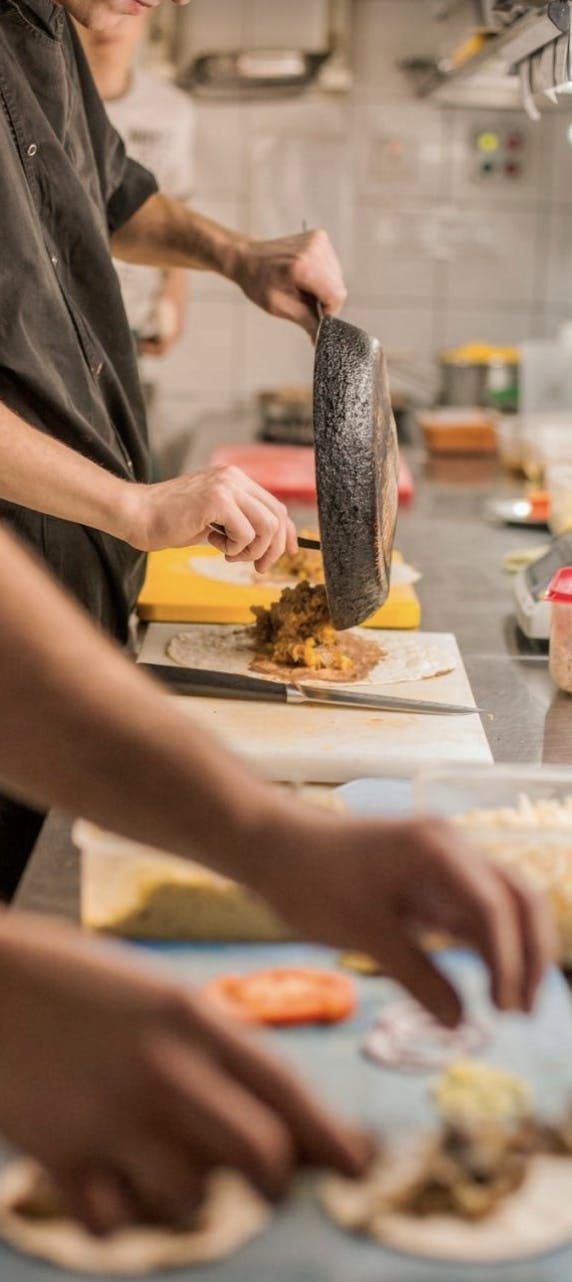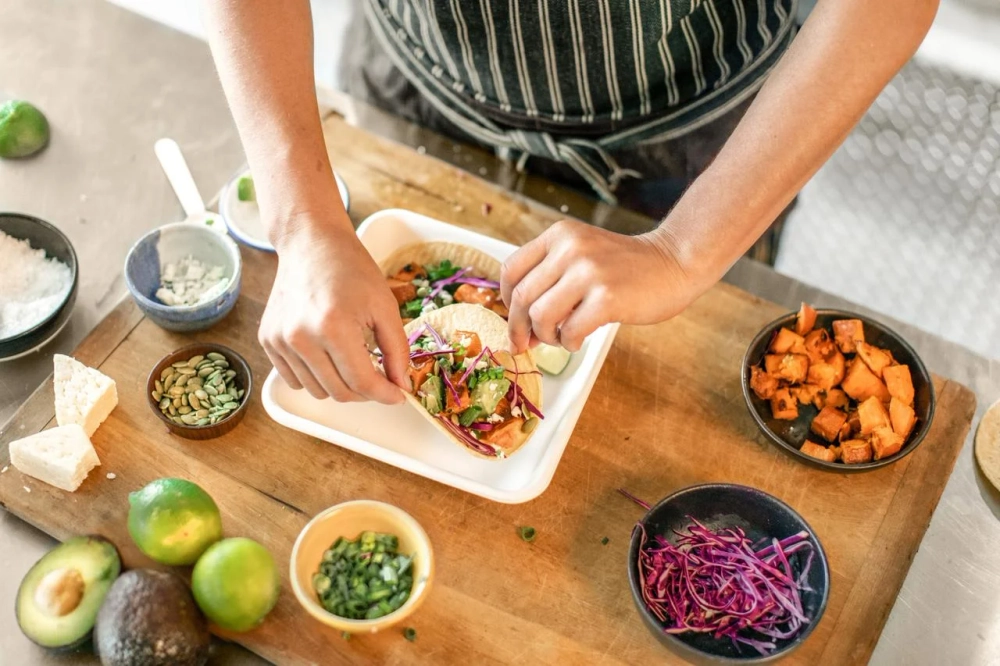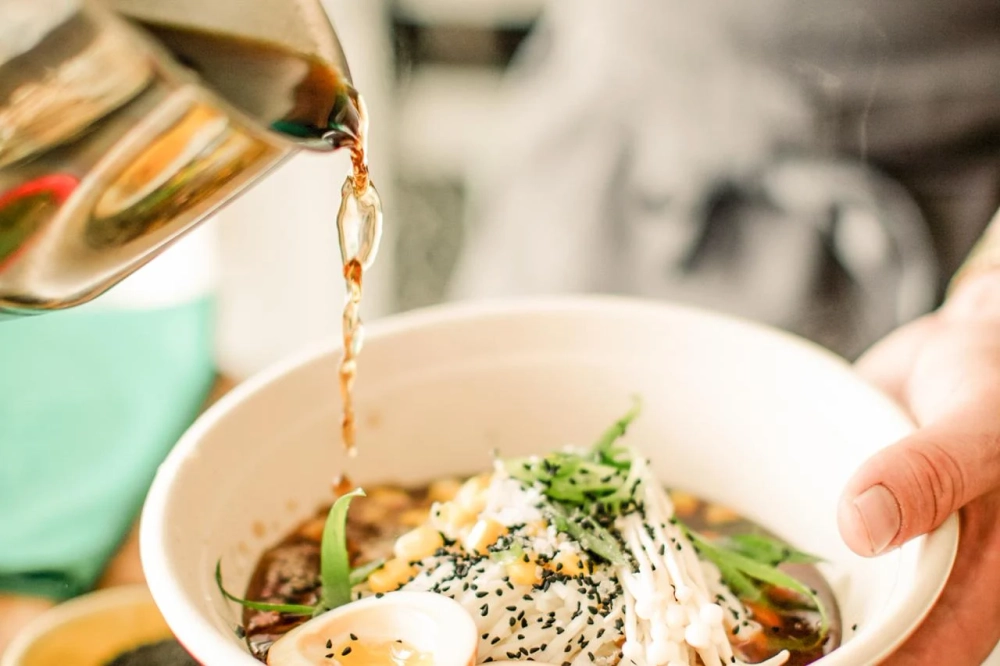What are the real costs of operating a franchise? A complete breakdown
Table of Contents
CloudKitchens
How many tacos can be delivered from a 1000sqft restaurant?
The same amount as a 200sqft ghost kitchen.
Picture this: your food and beverage business is soaring. Everything is just right—the menu is dialed in and the atmosphere is perfect. Your establishment is the talk of the town (and Yelp), with foodies jostling to line up before the doors even open.
What’s next? How can you etch your brand onto the broader culinary landscape?
Enter franchising, the logical and exciting next step toward expanding and elevating your single-location gem into a food brand. Whether it’s seizing the opportunity at a prime location across town or setting your sights on building a nationwide brand, opening up a franchise can be the golden ticket to even greater restaurant success.
But what are the costs associated with operating a franchise? From initial startup investments to ongoing fees, here’s what you need to consider as you build a budget and business plan.
What is franchising?
Franchising is an American business concept first started by McDonald’s—now the world’s largest restaurant franchise.
At its essence, a franchise is a type of business structure where the owners grant third parties the legal rights to use the restaurant’s name, branding, and business model in exchange for fees or ongoing royalties.
“For the most popular fast food franchises, start-up costs range from $10,000 to well over $1 million, and monthly fees, which are typically calculated as a percentage of gross sales, generally hover around the 5 percent mark, but can be as much as 50 percent…In the case of restaurants, franchisees serve the same menu (with occasional regional differences), feature the same advertisements, and use the same branding across the board.”
According to Eater
For an already flourishing restaurant, becoming a franchisor can be the logical next course on the menu of success. It’s a smart way to grow your brand and amplify your reach without shouldering the entire financial and logistical burden of expanding on your own. By franchising, you invite other entrepreneurs (the franchisees) to share in your success and carry your brand into new territories.
Conversely, for an ambitious entrepreneur, franchising can provide access to a turnkey business without having to build a brand from scratch. As a franchisee, you get to capitalize on an established brand’s intellectual property—their brand name, logo, recipes, systems, and business model—to launch and operate your own branch of the business.
What are the costs of franchising?
The specific costs of opening up a franchise can range from tens of thousands to millions of dollars, depending on the brand and the location you wish to operate in.
For instance, according to Light Speed, these are the startup costs from well-known franchise restaurants:
- Denny’s: $1,400,000 to $2,300,000
- Dunkin’: $131,000 to $1,900,000
- McDonald’s: $1,000,000 to $2,200,000
- Pizza Hut: $300,000 to $2,100,000
- Subway: $100,000 to $340,000
- Taco Bell: $530,000 to $3,000,000
- Tim Hortons: $60,000 to $665,000
It’s important to note that these estimated costs are just the initial ones—meaning, they’re what you’ll need to acquire the rights to use the brand and get started. On top of these, there are also the ongoing operational costs.
Ready to take a look at each of them?
Startup fees
Launching a franchise will involve various upfront costs, which can vary widely depending on the franchise’s size, location, and brand. That said, here’s a rundown of some of the more common startup fees you can expect to pay:
1. Franchise fee
A franchise fee is essentially a one-time payment by the franchisee to the franchisor for a ‘license to operate’, for a defined period. In exchange for the fee, the franchisee is granted the right to use the franchisor’s brand name, business model, and IP.
Depending on how established the brand is, the terms of the franchise deal, and the levels of support provided, this fee can range from $10,000 to $100,000.
For instance, Chick-fil-A purposefully operates on a model with low startup costs in exchange for much higher than typical monthly payments. According to the brand, “Chick-fil-A has a distinct franchise business model.
The Chick-fil-A franchise fee is very accessible at $10,000. Chick-fil-A corporation will pay for land, construction, and equipment for a restaurant, then rent it to the franchisee for 15% of sales plus 50% of pretax profit remaining.”
According to Eater, other Franchise fees include:
- Denny’s: $30,000
- Dunkin’: $40,000 to $90,000
- McDonald’s: $45,000
- Pizza Hut: $25,000
- Subway: $10,000 to 15,000
- Taco Bell: $25,000 to $50,000
- Tim Hortons: $25,000 to $50,000
2. Real estate
Do you plan on building a new restaurant, buying a pre-existing location from another franchisee, or converting an older restaurant into your new space? Do you plan to buy or lease?
Real estate costs can range between $100,000 to $1,000,000+, depending on the location and the size of the property.
3. Renovations and improvements
Some franchisees opt to pay more for a turnkey property, whereas others decide to remodel or refurbish the space to accommodate necessary changes. Additionally, certain brands require a location to follow a specific layout and floor plan.
Costs can range from $50,000 to $1,000,000+, depending on the work required to complete the project.
4. Equipment costs
If the location doesn’t already have all the necessary cooking equipment, technology, and tools necessary to operate the franchise, there will likely be substantial investment costs.
Equipment costs range between $10,000 to $100,000 or more.
5. Inventory
Once the location is ready to operate, you’ll need to ensure that you have enough stock on hand to open, including food and beverage items, cooking and cleaning supplies, utensils and equipment, bar supplies, and so on.
Inventory costs typically fall between $5,000 and $100,000.
6. Training expenses
Cover the costs for training to be provided by the franchisor to ensure that the franchisee is fully prepared to carry out the brand’s promise.
Training costs depend on the franchisor’s training program, length, location, and accommodations.
7. Legal and accounting fees
You’ll rely on professional lawyers and accountants to guide you through the franchising process. Legal and accounting costs depend on rates and hours hired.
8. Insurance
A franchisee is often required to obtain their own business insurance for covering accidents, liability, damages, or losses associated with operating a food business.
Insurance costs will vary depending on location, brand, and specific requirements outlined by the franchisor.
9. Licenses and permits
From health permits to liquor licenses, these costs cover the legal permitting necessary to operate your franchise.
Costs for licenses and permits will vary depending on the location and type of food and beverage business.
Ongoing Franchise Costs
Beyond the immediate, one-time start-up fees, the engine of your restaurant franchise relies on a continuous injection of funds. And we speak of those beyond the obvious, such as inventory or lease payments. For instance, franchisees must pay the following fees:
Franchise Royalty Fees
Typically expressed as a percentage of your franchise’s gross revenue per month, this is the kickback that incentivizes franchisors to continue improving and expanding the brand, developing new products, enhancing the operational model, and providing ongoing training and support. This can cost between 4% and 8% of gross revenue depending on the brand.
Marketing Expenses
In addition to royalties, many franchisors will collect an additional marketing fee from every franchisee that is used to support the brand’s local and national advertising campaigns and digital initiatives. These can cost between 2% to 5% of gross revenue.
Operating Costs
Operating costs are the fundamental expenses required to keep your franchise running. This category includes expenses like utilities (electricity, water), the ingredients used for production, and even equipment maintenance.
Naturally, the larger the operation, the higher these ongoing expenses tend to be to maintain the business.
Staff Wages and Training
Finding “good people” is integral to the smooth operation of your franchise. This expense is all about putting together a winning team that embodies your brand’s ethos and service standards. Naturally, a major percentage of the operating budget will be devoted to labor and management, including both front and back house staff.
The costs of finding and managing your staff will vary, but it should account for the finding, hiring, onboarding, training, and paying the employee’s salary.
Ghost kitchens: the easier and cheaper way to expand and franchise a food business
In the age of Uber Eats and DoorDash, the concept of franchising has evolved. In the past, becoming a franchisee required that you establish a physical, brick-and-mortar location—and pay all the associated fees necessary to make that space operational.
Today, there’s a faster and cheaper way to expand and franchise your food business: the ghost kitchen.
Sometimes referred to as a virtual kitchen, a ghost kitchen is a commercial cooking space that exists solely to prepare food for delivery. As such, they eliminate many of the significant costs to open up a new franchise, particularly big-ticket items like:
- Real-estate
- Equipment maintenance
- Dining area and furniture
- Front-of-house staff
- Licensing and permitting for dining services
With ghost kitchens, food businesses can now expand their reach and franchise without many of the financial burdens of traditional brick-and-mortar establishments.
Franchise easily with a ghost kitchen from CloudKitchens
Franchising can be a time- money-, and labor-intensive process that makes many would-be restaurateurs balk at the significant upfront risks and investments.
But with CloudKitchens, expanding and franchising into food delivery has never been easier. Our revolutionary model can help you set up an operational and permitted kitchen for your franchise in as little as 4 weeks for a fraction of the cost. Every space comes with:
- 200 ft2 commercial kitchen space
- Operational and services support
- Basic kitchen equipment
- Utilities and maintenance
Need a facility for your upcoming expansion? We have everything from ghost kitchens in Austin to commercial kitchens in Los Angeles. Get ready to embrace the neo-franchise model and tour your future kitchen today! Tour your future kitchen today!
Read more:
- How To Structure a Franchise Business Plan: 9 Steps
- The Ultimate Guide to Franchise Marketing | CloudKitchens
- How to measure the restaurant franchise success rate?
- Restaurant Franchise | CloudKitchens
- How to Franchise a Restaurant: Guide for Success
Explore ghost kitchen locations across the US:
- Ghost kitchens in San Francisco
- Ghost kitchens in LA
- Ghost kitchens in NYC
- Ghost Kitchens in Toronto
- Ghost Kitchens in Atlanta
- Ghost Kitchens in Dallas
- Ghost Kitchens in Chicago
- Ghost Kitchens in Denver
- Ghost Kitchens in Miami
| DISCLAIMER: This information is provided for general informational purposes only and the content does not constitute an endorsement. CloudKitchens does not warrant the accuracy or completeness of any information, text, images/graphics, links, or other content contained within the blog content. We recommend that you consult with financial, legal, and business professionals for advice specific to your situation. |
Sources:
Investopedia. 10 Biggest Restaurant Companies. https://www.investopedia.com/articles/markets/012516/worlds-top-10-restaurant-companies-mcdsbux.asp
Eater. Franchising a Restaurant, Explained. https://www.eater.com/2017/5/8/14936008/how-to-franchise-restaurant-mcdonalds-arbys-subway
Lightspeed. The Beginner’s Guide to Franchise Restaurants. https://www.lightspeedhq.com/blog/franchise-restaurants/
Chick-Fil-A. Franchise Help. https://www.franchisehelp.com/franchises/chick-fil-a/
Please note that this article is for informational purposes only and is not intended as tax, legal, HR, accounting, or other professional advice.
More insights & stories
There’s more where that came from.
Get in the know and check out our additional insights




